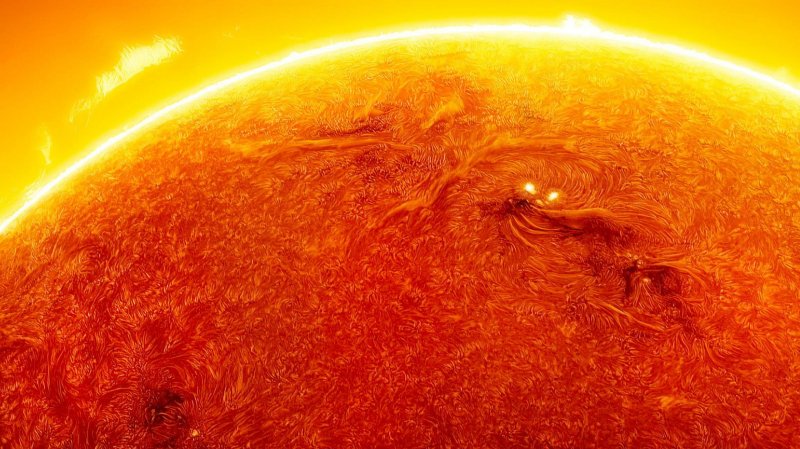NASA: Earth to Face Intense Solar Storm with Potential Blackouts and Stunning Auroras

NASA: Earth to Face Intense Solar Storm with Potential Blackouts and Stunning Auroras
Space weather enthusiasts and everyday people alike have something big to watch out for — NASA has issued a warning about an intense solar storm heading toward Earth. This storm promises to bring dazzling auroras visible far beyond the usual polar regions but also carries the risk of disrupting our electrical grids and communication systems. What exactly is a solar storm, and how might it affect life on Earth? Let’s dive into what NASA is telling us and what to expect.
What Is a Solar Storm?
Solar storms, also known as geomagnetic storms, occur when the Sun releases a massive burst of charged particles and magnetic fields into space. These bursts, often caused by solar flares or coronal mass ejections (CMEs), travel through the solar system at millions of miles per hour.
When this solar material reaches Earth’s magnetic field, it interacts with the magnetosphere and atmosphere, causing disturbances that can range from beautiful natural light shows to serious disruptions in technology.
Why Is This Storm Different?

According to NASA and other space weather monitoring agencies, this upcoming solar storm is one of the most intense expected in recent years. The storm is the result of a strong CME from an active sunspot region, which launched a wave of energetic particles toward Earth.
The timing is crucial: Earth’s magnetic field may be temporarily overwhelmed by this influx, causing a geomagnetic storm strong enough to affect satellites, power grids, and radio communications.
Potential Impacts: Blackouts and Communication Disruptions
One of the biggest concerns with intense solar storms is their potential to cause blackouts. Here’s how:
- Power Grids: Solar storms induce electric currents in long conductors like power lines. This can overload transformers and cause widespread outages. The 1989 Quebec blackout, which left millions without power for hours, was caused by a geomagnetic storm.
- Satellites and GPS: The charged particles can damage or interfere with satellites, disrupting GPS signals, satellite phones, and even TV broadcasts.
- Radio Communications: High-frequency radio waves used for aviation and marine communications can be absorbed or reflected erratically, causing loss of contact in critical situations.
While utilities and governments have learned to better prepare for such events, a storm of this magnitude could still present significant challenges.
The Bright Side: Spectacular Auroras
If there’s a silver lining, it’s in the sky’s light show. Auroras—also known as the Northern and Southern Lights—occur when solar particles excite gases in the Earth’s atmosphere, causing them to glow in colorful displays.
Normally, auroras are confined to high-latitude regions near the poles. But during intense storms like this one, auroras can be seen much farther south than usual—sometimes as far south as the northern United States or parts of Europe.
For those lucky enough to be under clear skies, this will be a rare opportunity to witness breathtaking curtains of green, purple, and red lights dancing across the night sky.
How Can You Prepare?
Though the risk of severe damage is relatively low, it’s wise to be prepared, especially if you live in regions prone to power outages.

- Stay Informed: Follow updates from NASA, NOAA’s Space Weather Prediction Center, and local news. They provide real-time alerts and advice.
- Backup Power: If you rely on medical devices or essential electronics, having a backup battery or generator is a smart precaution.
- Protect Electronics: Unplug sensitive electronics during the storm to avoid damage from power surges.
- Enjoy the Show: If conditions are right, step outside after dark to witness the auroras, but remember to dress warmly!
Looking Ahead: The Importance of Monitoring Space Weather
Solar storms remind us how closely connected our modern life is to the Sun’s activity. As our reliance on technology grows, understanding and predicting space weather becomes increasingly important.
NASA and other space agencies continuously monitor solar activity using satellites like the Solar Dynamics Observatory and the DSCOVR spacecraft. These tools help scientists forecast storms hours or days in advance, giving us a chance to prepare.
Final Thoughts
While an intense solar storm might sound alarming, it’s a natural and periodic event in the Sun’s 11-year activity cycle. With modern technology and early warnings, the risks to our infrastructure can be managed.
For many, the coming days may bring a chance to experience one of nature’s most stunning spectacles — the auroras — lighting up the night sky with vibrant colors.
Stay safe, stay informed, and keep your eyes on the skies!









